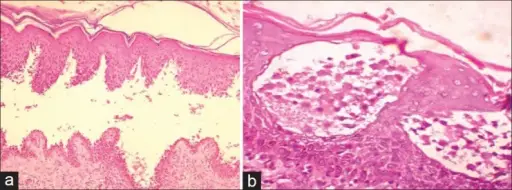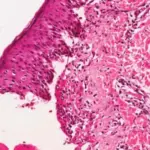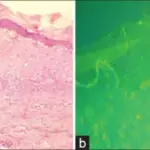Pemphigus vulgaris is an autoimmune blistering disorder affecting the skin and the cutaneous layer and causes the formation of flaccid bullae on the skin and mucosa.
What is the Pathology of Pemphigus Vulgaris?
The pathology of pemphigus vulgaris is: the study of the disease affecting the skin and the mucosa.
-Etiology: The cause of pemphigus vulgaris is a result of autoimmunity but can be triggered by environmental factors e.g. exposure to chemicals.
-Genes involved: None.
-Pathogenesis: The sequence of events that lead to pemphigus vulgaris antibody-mediated hypersensitivity causes the formation of lesions.
-Morphology: The morphology associated with pemphigus vulgaris shows superficial flaccid vesicles and bullae that rupture easily.
-Histology: The histology associated with pemphigus vulgaris shows supra basal bullae in location so that the basal layer remains attached to the dermis like a row of tombstones. The bullous cavity contains serum and acantholytic epidermal cells.
How does Pemphigus Vulgaris Present?
Patients with pemphigus vulgaris typically are the elderly and most common in males than females. age of 50-60 years. The symptoms, features, and clinical findings associated with pemphigus vulgaris include very painfulness, secondary infection, itchiness, discomfort, formation of blisters.
How is Pemphigus Vulgaris Diagnosed?
The diagnosis of pemphigus vulgaris is histopathology, direct and indirect immunofluorescence,
How is Pemphigus Vulgaris Treated?
The pemphigus vulgaris is treated immunosuppressive therapy, corticosteroids to inhibit inflammation, anti-tumor necrosis factor drugs.
What is the Prognosis of Pemphigus Vulgaris?
The prognosis of pemphigus vulgaris is good in childhood than in adulthood. If the disease is in a few areas the prognosis is good than if it has widespread.



